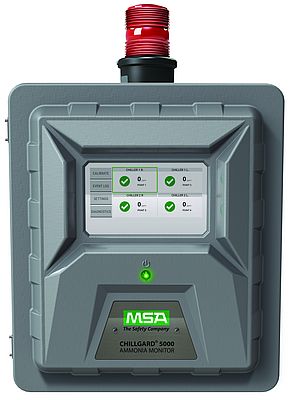The new Chillard 5000 Ammonia Leak Monitor from MSA Safety offers highly reliable toxic gas detection to protect people and equipment in the food/beverage, pharmaceutical, chemical, electric power generation and other industries.
Up to 16 sampling points monitored from one calibration port
The Chillgard 5000 Ammonia Leak Monitor utilizes Photoacoustic Infrared (PAIR) sensor technology, which provides a rapid response at the 10 parts-per-million level for early notification. They are highly accurate too: 0–50 ppm ±1 ppm, 51–1000 ppm ±10% of reading. PAIR sensors are not affected by temperature and humidity swings, which minimizes drift unlike other detection technologies. They are also immune to sensor interferants, such as cleaning agents and solvents. Designed for easy installation, the Chillgard 5000 Ammonia Leak Monitor can be configured with 4, 8 or 16 sampling points all at once from its single dedicated calibration port. This capability eliminates the typical arduous effort and cost required by other gas sensor technologies to calibrate the multiple sensors that must be placed on ceilings in larger production areas or buildings for adequate coverage due to the lighter than air nature of ammonia gas.
Built-in performance diagnose
Technicians will appreciate the Chillgard 5000 Ammonia Leak Monitor’s large, highly intuitive local user interface touch-screen color display (7-inches, 178 mm) with real-time text and graphics. It is multilingual, password protectable and offers them easy access to detector settings, event log data and diagnostics. With a built-in predictive maintenance feature set, it provides early performance diagnoses to keep plants running 24/7 and avoid costly product batch quality and spoilage issues or complete shutdowns. The Chillgard 5000 Ammonia Leak Monitor includes integrated Modbus and BACnet for direct digital communication back to a centralized control system, such as a DCS or PLCs, and/or to a Building Management Systems (BMS). BACnet protocol allows for non-intrusive gas concentration monitoring and alarm status. No configuration is necessary because the data is automatically mapped into the database upon protocol selection.

















